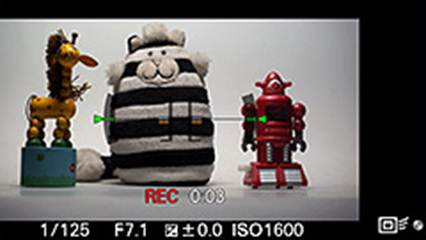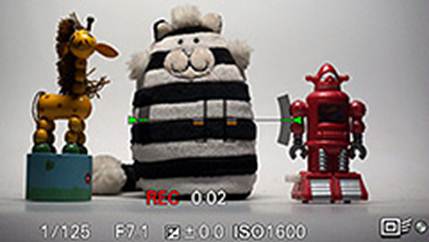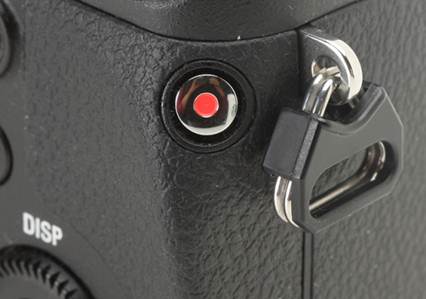Built-in Flash
The NEX-6 provides an integrated flash; something is missing
from the NEX-5R (but is now getting more popular in the NEX lineup since it is
more mature). Like all of the mirrorless cameras, the built-in flash of the
NEX-6 will not win any awards for its performance. With a guide number of 6
meters at ISO 100, the flash is the best appropriate for capturing objects in
the vicinity.

For close-range
portrait shots, the built-in flash of the NEX-6 offers good coverage and
well-balanced flash exposures as well. In this photo, the subject’s color skin
is nice and balanced, without the ‘burnt out’ appearance like some portraits
taken with the flash light.
The flash offers decent coverage across the frame in all of
our portrait test images, and skin tones are the same color as the original,
with a decent balance of flash and ambient light. Red-eye phenomenon did not
appear frequently in our experiment.
Movie mode
The NEX-6 has the same movie mode as its big sibling, the
NEX-7, which means that it has ability to record full 1,080/60p video with
stereo sound. Sony’s PlayMemories Home software allows for full editing of your
movies, and for being able to write 60p movies directly to a Blu-ray disc. It
should be noted that not all Blu-ray players support 1,080/60p playback.

The default view
when recording movies is cut off, leaving wide margins around the region being
recorded. Exposure parameters and a timer are displayed.

To remove the margins
and take advantage of the NEX’s 16:9 LCD, change the 'wide Image’ option to
'Full screen’.
While the NEX-6’s video button is difficult to press wrongly
in its position on the right shoulder of the camera (the inadvertent operation
is most criticized for the NEX-7), it is also difficult to hit when you really
want to start filming. Placing the rec button at 45 degree angle recessed into
the right side of the camera requires a hold with both hands, since it is an
unwieldy stretch with your hand in shooting (static) position. While the movie
record button on the NEX-7 is too easy to hit wrongly, the version on the NEX-6
is almost too hard to hit when intending to use.

The movie record
button of the NEX-6 is placed concavely, somewhat awkwardly, along the right
edge of the camera at a 45 degree angle. While requiring a hold of the camera
with both hands, its position prevents wrong operation, which is a serious
problem towards the NEX-7.
The NEX-6 will respect all of your exposure settings in the
movie mode (multiple cameras default to fully auto as soon as you hit the movie
record button). What's more, everything is likely to be varied while you are
filming, shutter speed, aperture, ISO, and exposure compensation, depending on
the mode you stay in. If you are using Flexible Spot AF mode, then you will be
able to move the focus point around while you're filming. If using Multi AF, an
object tracking option will be available. It should be noted that Hybrid AF is
sadly (autofocus hybrid) not in the movie recording mode. There is also a wind
filter to reduce background noise while shooting video outdoors, which performs
well – there is an example below of this page.
Aside from the manual controls, you are also able to throw
the camera into any the Auto modes and take advantage of the functions of
Creative Styles or Picture Effects that are available for static shooting. When
it comes to the static images, you are unable to take pictures while
simultaneously filming, but you can with a few opponents of the NEX-6
Below are the numerous video sizes and quality settings
available on the NEX-6. Note that the default setting is 1,080/60i and there is
no higher quality 1,080/60p option.
Sizes
·
AVCHD: 1,920 x 1,080 60i/50i Avg. 24 Mbps (high quality), 1,920 x
1,080 60i/50i Avg. 17 Mbps (standard quality), 1,920 x 1,080 60p Avg. 28 Mbps
(highest quality), 1,920 x 1,080 24p/25p Avg. 24Mbps (High Quality) 1,920 x
1,080 24p/25p Avg. 17Mbps (standard quality)
·
MP4: 1,440 x 1,080, 1,080p (30/25fps), Av. 12 Mbps, 640 x 480
(30/25fps), Av. 3Mbps
Sound
·
Dolby Digital Audio
·
Stereo audio capture via the integrated or optional external
microphone
Format
·
AVCHD / MPEG4
Recordable time
·
Approximately 29 minutes and 20 minutes for AVCHD and MPEG4
(1,440 x 1,080) respectively
One thing we took notice about filming on the NEX-6 is that
there is approximately 0.5 - 1.0 seconds of noise between the time you hit the
red button and when filming starts and ends. This may cause powerful
frustration when referring to ''grab shots' of fast moving objects.
As for quality, it's great in most respects. At 60p, videos
are smooth and detailed. Action is well recorded, and there's very little moiré
orartifacting (although the footage is not entirely without these problems, as
you are able to see in one of the videos below). In low light conditions, noise
levels are kept under control, although the camera has to struggle to focus at
more times, resulting in 'sharp hunting' in the low-light footages. Not
unexpectedly, the autofocus illuminator does not work during movie recording,
just making preparations beforehand, for initial autofocus detection when
you're recording the landscapes.
Mounted in front of the NEX-6, microphone records much wind
noise, so make sure that you switch on the wind filter when recording videos
outdoors. View the sample video 4 for an opinion on its effectiveness.